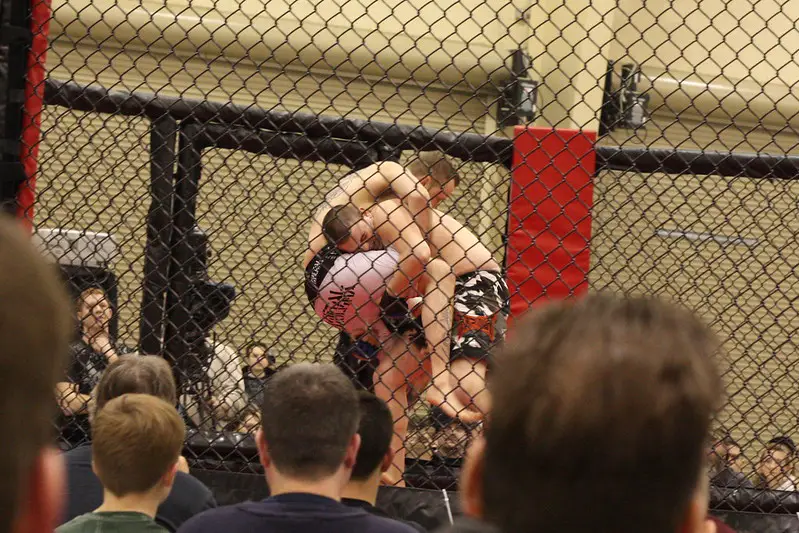MMA is a versatile combat system and in this article, you will discover how effective MMA is for self-defense and combat scenarios you may encounter in real life.
We will also go deep into the technical aspects of the system, and bring you the key advantages of MMA for self-defense, as well as the cons you should be aware of.
Is MMA Good For Self-Defense?
MMA is among the best self-defense martial arts one can train in to develop physical and mental skills for real combat. The system includes striking and grappling on the feet, ground, and clinch and trains you to mix only the best techniques from multiple martial arts to adapt to any combat scenario.
For instance, the majority of other combat sports are quite limited. Boxing focuses solely on punches, while kickboxing styles emphasize standup only. The same stands for judo, BJJ and wrestling focusing only on grappling.
Mixed martial arts is different because it actually combines only the best techniques from all of these styles. It teaches you how to:
- Use punches and footwork (Boxing)
- Kick and strike at all ranges (Muay Thai)
- Wrestle on the feet and ground (Wrestling and Judo)
- Battle on the ground using positioning and submissions (BJJ)
Training is realistic too. Sparring against fully resisting opponents and testing your skills in real situations is a regular part of training.
This makes MMA effective for self-defense and in line with the violent and unpredictable nature of real fighting where you need to constantly adapt to new dynamics. Whether it’s striking or grappling in the open or closed space, you will have the tools to navigate your way to safety.
However, MMA is a sport where you learn how to use specific techniques and obey the rules. As such, there is an absence of advanced defensive techniques and skills we are going to explain later.
Why MMA is Good For Self-Defense?
The key reason is the versatility of the system and techniques that cover most fighting scenarios, and the realism of training that prepares practitioners to actually apply these techniques skills under pressure.
Here is a detailed explanation:
Makes You Superior
Techniques cover a lot of self-defense scenarios
MMA combines techniques from various martial arts disciplines such as Brazilian Jiu-Jitsu, Muay Thai, wrestling, boxing, and others. This versatility allows practitioners to adapt to different situations, including standing strikes, clinches, takedowns, and ground fighting.
If the fight is in the close space, practitioners will know how to pull a clinch, and use it to land damage or secure a takedown. In case the fight is in the open, MMA trains them to keep their range using long-range punches kicks and footwork.
Realistic Training
MMA training often involves live sparring sessions where practitioners face resisting opponents. This realism helps students develop the skills needed to defend themselves in actual combat situations, where opponents may not follow prearranged patterns or techniques.
This forces students to think quickly, adapt their strategies on the fly, and develop effective counterattacks in real time. This hands-on approach fosters not only technical proficiency but also mental resilience, as students learn to remain composed and focused under duress.
By repeatedly testing their skills against resisting opponents, they gain invaluable experience in assessing and reacting to varying levels of:
- Attacking patterns
- Aggression and pressure
- Intensity
Trains Body and Mind to Deal with Pain
The intensity of live sparring in MMA training not only refines physical techniques but also conditions the body to endure and absorb impact. This is important for self-defense where it is likely you will have to take a shot or two.
All the skill and technique mean nothing if you don’t have the ability to absorb damage and pain. MMA conditions the body to deal with damage and respond to pain. This is important because it prevents the mind from going into panic mode.
Most regular people lose confidence upon being hit and feeling any pain. But through sparring, you learn how to ignore this and stay focused on the task — defending and neutralizing the threat.
Once the attacker blasts you with a punch or kick, the mind will recognize that this is the same shot you regularly go through in training, and thus, stay calm and enable you to respond.
Why MMA is Bad for Self-Defense?
The key reasons are related to the absence of proper self-defense training methods such as de-escalation techniques, situational awareness, as well as weapon-based training and dealing with multiple attackers.
Here is a more detailed explanation:
Emphasizes physical contact and engagement
MMA trains your instincts to always respond in an offensive manner. This is bad because you can resolve a lot of fight situations by simply running away, talking your way out, or executing a certain move to back off the attacker before running away.
In training, practitioners only learn how to effectively respond using striking and grappling as their main objective is to finish the fight as fast as possible. They don’t practice awareness or other methods that prioritize avoiding physical confrontation as the best option.
Lack of De-escalation and Situational awareness
MMA training primarily emphasizes physical techniques for neutralizing threats. But out in the real world, de-escalation techniques and situational awareness are perhaps even more important.
Proper self-defense programs MUST involve communication techniques where students learn how to de-escalate situations, read the attackers’ movements, anticipate their actions, and maintain high awareness.
In a lot of cases, you can avoid physical confrontation and resolve all the issues if you are well-trained.
Emphasis on Sport vs. Street Defense
MMA is a combat sport. Training primarily focuses on physical techniques for neutralizing threats within the specific rule set and environment. These rules and controlled environments influence training priorities and techniques.
While effective for fighting within the confines of a controlled environment, some techniques may be less suitable or even dangerous in a self-defense context where there are no rules or referees to enforce fair play. This includes common situations such as:
- Dealing with multiple attackers
- Dealing with dirty moves such as strikes to the throat, groins, eye gouging etc.
- Multiple attacker scenarios
- Different weapons
Overconfidence
While MMA training can boost self-confidence and competence in physical confrontations, there is a risk of individuals becoming overconfident in their abilities. This overconfidence may lead to a false sense of security and could result in individuals placing themselves in unnecessarily risky situations or failing to recognize when to avoid or escape from a potential threat.
Physical Requirements
MMA training can be physically demanding and may not be suitable for everyone. This is notably true for those with pre-existing injuries, mobility issues, or other health concerns. Training is simply not as adaptable to all ages and individual factors as other systems like Krav Maga for instance.
Thus, it might be suitable for the younger generation that has a lot of free time on their hand. However, it might not be worth investing a lot of time for adults and older people looking for proper training.
5 MMA Self-Defense Techniques You Should Know
Here are five fundamental MMA self-defense techniques you can use to protect yourself in real life:
Push Kick
This technique is excellent for maintaining distance from an aggressor. Push kick to the chest or abdomen can create space and buy you time to escape.
It works well in the open space area where you have enough space to throw the kick the right way to generate power. The kick can easily knock the wind out of the attackers’ lungs, hurt their abdomen, break ribs, etc.
Clinch Work
Most fighting scenarios include pushing and grabbing at close range. This makes Thai clinching techniques close to ideal for this type of situation. You can use this chaotic situation to your advantage to quickly secure a strong control of the opponent, throw them down or do damage with knees and elbows.
Jab-Cross Combo
The jab-cross is one of the most fundamental striking combos. The jab sets up the cross, creating an opening for a powerful straight punch.
This combo is effective for both offense and defense, allowing you to control the distance and keep your opponent on the defensive while setting up further attacks or defensive manoeuvres.
Basic Footwork
Mastering movement allows you to control distance, create angles, and evade attacks. It is notably effective in real life since most regular people do not know how to move at attack in a straight line. It is also effective against aggressive opponents who rely on pressure and forward momentum.
Block/Slip and Counter
Blocking incoming strikes and slipping punches is crucial. These defensive techniques allow you to not only protect yourself but also cause the attacker to overshoot with the strike. This puts them off balance and you in a position to counter and run away.
Takedowns
Understanding takedowns allows you to dictate the fight’s positioning and take control of your opponent. Techniques such as the double-leg takedown, single-leg takedown, or hip throw can be effective in neutralizing an aggressor and gaining a dominant position on the ground.
Also, takedowns and throws are effective in real-life fighting because the majority of people don’t know how to stop a grappling attack.
Should You Learn MMA for Self-Defense?
MMA is a great option for all the people looking to develop all-around combat skills and learn how to use them in real life. But before joining the academy, be aware that MMA is NOT designed for self-defense.
If your primary goal is to learn practical skills that you can use in real-world situations, then learning MMA can be beneficial. The system incorporates techniques from various martial arts disciplines, including striking, grappling, and submissions, providing a well-rounded skill set for self-defense.
It equips you with effective striking and grappling techniques that work in freestyle combat. However, that’s about it and do not expect to learn anything more.
If this doesn’t align with your goals and you want to learn more about the violent and unpredictable nature of real fighting then you would need to look for alternatives such as Krav Maga, Combat Sambo, and other systems designed specifically for self-defence.
Conventional martial arts techniques such as kicks and punches are maybe not as advanced in these systems as in MMA. The same could be said for realistic training methods. But, a proper self-defence system includes important aspects of training that MMA doesn’t such as:
- How to de-escalate the situation
- How to fight against multiple opponents
- Specific drills that simulate re-world environments
- Situational awareness


